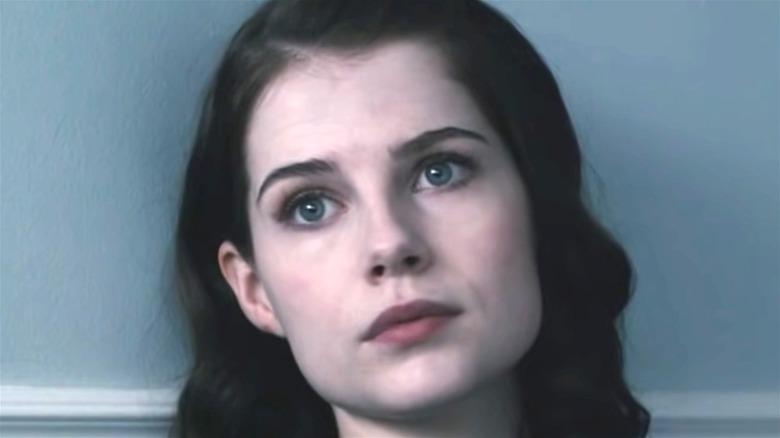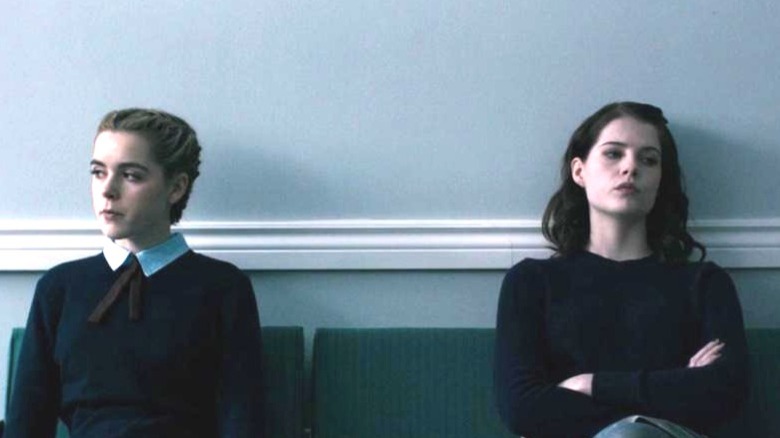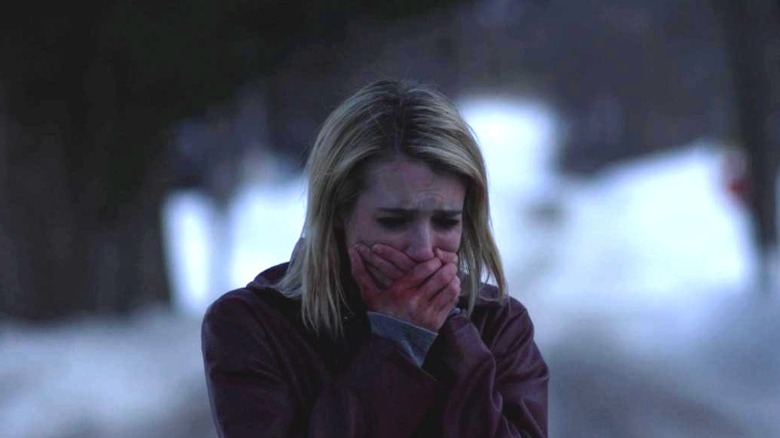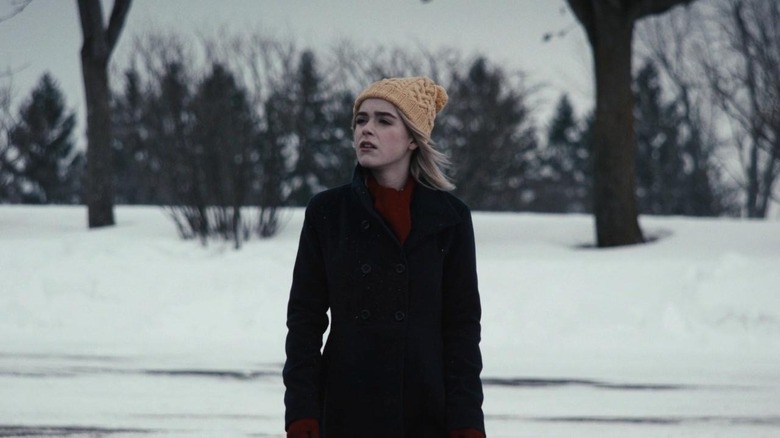The Ending Of The Blackcoat's Daughter Explained
Oz Perkins' film about demonic possession is subtle and can be overwhelming upon first viewing. "The Blackcoat's Daughter" stars Emma Roberts and Kiernan Shipka, even before she was Sabrina Spellman in "Chilling Adventures of Sabrina." There is no surprise that Shipka was cast as Netflix's Sabrina after this film — the actress' performance as the possessed schoolgirl Kat is haunting and disturbing. While on winter break at a Catholic private school, Kat becomes possessed by a demonic entity found in the boiler room. Her victims become a classmate, Rose (Lucy Boynton), and the remaining nuns there.
The film deals with the repercussions of the violent act, as well as a separate story involving a woman named Joan (Roberts) who has just left a mental institution. The connection between Kat and Joan isn't inherently obvious, but it's an important element of the film. By the end of "The Blackcoat's Daughter," Joan makes her way back to Bramford, the school where the carnage takes place. On the way, she encounters Rose's parents and kills them, taking their remains back to the school with her.
Joan is heartbroken to find that there is no longer a demon in the boiler room, despite her efforts to please them. The film concludes with Joan walking from the school and emotionally breaking down. These events are woven together intricately, but there is more to understand beneath the surface.
The movie takes place on two different timelines
"The Blackcoat's Daughter" is separated into three sections, and each section is subtitled after the name of a character: Rose, Joan, and Kat. Rose kicks off the film and is quite straightforward. She puts off seeing her parents because she is afraid that she's pregnant. The film continues with Joan's section as she befriends a couple trying to make it to Bramford. It is implied that these two events are taking place at the same time as the film flips between Rose and Joan. But in fact, Joan's story takes place nine years after Rose's murder.
While on the road to Bramford, it is revealed that Joan is actually Kat, who has stolen someone's identity, meaning Shipka and Roberts play the same character, nine years apart. This brings the film to an even darker place. While at Bramford in the past, a young Kat kills Rose as a sacrifice to her demon. Nine years later, "Joan" is trying to make her way back to where the events take place, and her motives are largely a secret as she encounters a grieving couple who also happen to be Rose's parents. If viewers think Joan is feeling grief or guilt for killing their daughter, this is proven false when she murders them as well in the same ritualistic manner as before. Despite how brutal the plot is, "The Blackcoat's Daughter" is not just about the events, but the meaning behind it.
Even demon worshippers get lonely
The twist of Joan and Kat being the same person is important because it illuminates what Kat is feeling and her motivations. Kat is hospitalized after the murders, and the headmaster of Bramford returns to perform an exorcism on her. He tells the demon to get out of this "poor girl." After iconic horror films such as "The Exorcist," it would stand to reason that Kat wouldn't want a demon inside her. But as the demon leaves, she begs it not to go.
This is contrasted with how Joan returns to Bramford. Having just killed Rose's parents, she brings them to the boiler room. But the boiler is cold, with no evidence of the demon still remaining. Devastated, Joan leaves the school. Her entire plan is about returning to school and finding her demon again, and her cries echo a sadness that anyone can understand.
Whether or not audience members understand demon possession, there is something universal about loneliness. Joan cries because she has to confront the fact that after all this time, she is still alone. Director Oz Perkins echoes this in an interview he did with Fast Company. "It's meant to be a portrait of grief and loss and the space that's left behind when you lose big," the director stated. Horror does its best as a metaphor, and "The Blackcoat's Daughter" resonates emotionally because of these themes.
The Blackcoat's Daughter highlights the complexity of women in horror
"The Blackcoat's Daughter" continues the new push in horror to display the interior lives of women. Oftentimes, these experiences are horrific. For example, another popular horror movie of this era is "It Follows," which focuses on a young woman who is constantly stalked by an entity after sexual contact. But perhaps the closest comparison is Robert Eggers' "The Witch," which also shows a young woman making a choice that others may not understand.
In "The Witch," Thomasin (Anya Taylor-Joy) is blamed by her mother for everything that is wrong with the family and their life. This pushes Thomasin to sign her name in the Dark Lord's book in the ending of "The Witch." This decision gives her freedom that she doesn't have in her human life. Just like in "The Witch," "The Blackcoat's Daughter" analyzes the complexity of female characters in a way that is not always found in other genres or mediums. Kat has wants that are not obvious upon first viewing, and the film does not judge her for her actions, instead showing a haunting portrait of how horrifying it is to feel pain and loneliness.



